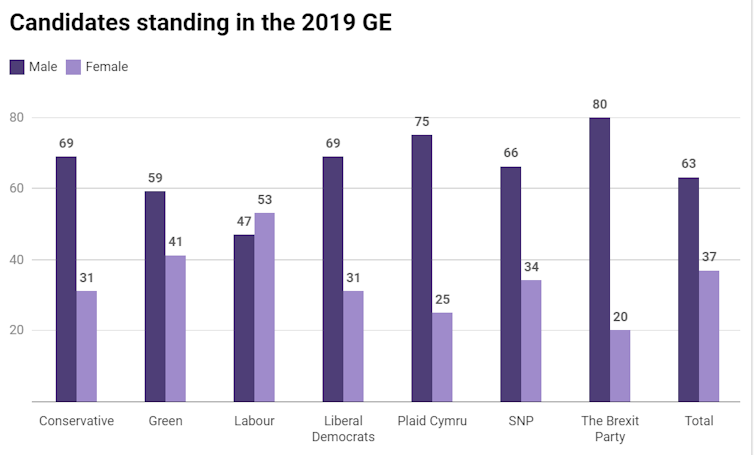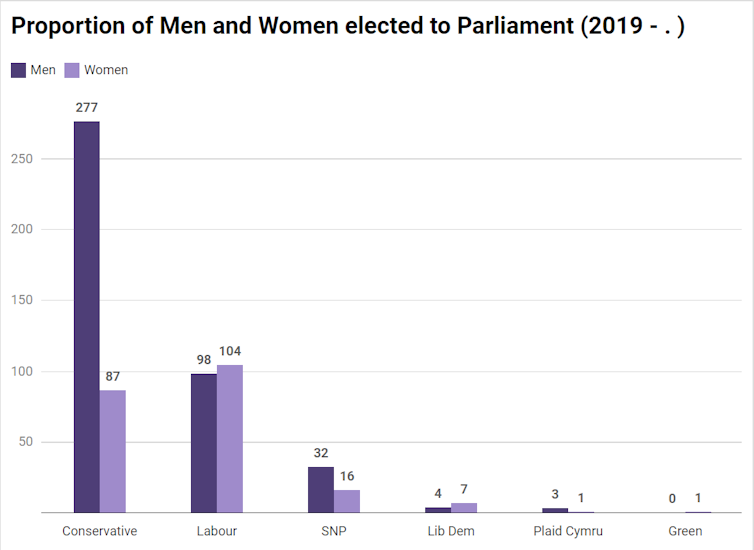A record number of women presented themselves for office ahead of the UK’s 2019 election.
A total of 37 percent of candidates were female – an improvement of eight percentage points over the number of women standing in 2017 (29 percent), and 11 percentage points compared to 2015 (26 percent). This is despite how challenging it can be to organise a campaign for a snap election.
It’s also perhaps surprising given the revelations made by women MPs over the past year about the abuse that they receive from the public. When the general election was called, around 20 women from different parties announced they had decided to stand down.
Among them were Conservatives Amber Rudd, Nicky Morgan, Caroline Spelman, Seema Kennedy and their former Conservative colleague Heidi Allen, as well as Labour MPs Louise Ellmann and Gloria De Piero.
Many of these women cited daily abuse, harassment, and intimidation as a reason for leaving Parliament. This suggests that the aggressiveness of the political environment is undermining efforts to improve representation in the UK.

Yet there are important variations between parties when it comes to how many women they selected to stand. I’ve analysed the data for 2019 and found that Labour became the first party in UK history to offer the electorate more female candidates (53 percent of the total) than men (47 percent). This represented an increase of 11 percentage points over previous elections.
The Liberal Democrats increased the proportion of women by 29 percentage points so that 31 percent of their candidates were women. The Conservative party only increased the number of female candidates by one percentage point, reaching 31 percent of the total candidates.
Such significant variations may reflect differences in the demographic composition of the party membership, but most likely reflect differences in party attitudes towards gender equality and their commitment to implementing actions that actively encourage women to become candidates.
The New Parliament
This year, a record number of female candidates will become MPs. Out of a total of 650 MPs, there will be 220 women sitting in the House of Commons. That means they make up 34 percent of the total number of seats in the House of Commons, an increase of five percentage points.
However, this important achievement comes with two caveats. According to the 2011 Census, women and girls made up 51 percent of the population in the UK, so the House of Commons is still 17 percentage points away from parity.

The second caveat relates to the distribution of seats. For the first time in history, more than half of one party’s seats will be occupied by women – but it’s the party of opposition rather than the party of government. While 51 percent of Labour MPs are now women, only 24 percent of Conservatives are. So 40 percent of women MPs will be in government, and 60 percent in opposition.
Getting Women In, Getting Them To Stay
There are two ways to increase the proportion of women in the House of Commons. Either they win a seat from a male incumbent MP or they win one that has been left vacant because the MP did not seek re-election. The analysis of the seats that changed hands between women and men after the 2019 election indicates that both sexes are equally likely to challenge and win from an incumbent. Yet, women are significantly more likely to win a seat that has been left vacant.
This year, 68 percent of women stepping down were replaced by other women and 56 percent of men were replaced by other men. Only 44 percent of male MPs were replaced by women.
Then comes the matter of preventing another situation like 2019, when so many women decided not to stay on in parliament. Survey-based data suggests that during the 2017 election campaign, 38 percent of candidates suffered from abuse, harassment or intimidation and that these actions targeted women.
About one in every two women competing for a seat suffered at least one form of abuse, which put them about ten percentage points above the proportion of men. Once controlling for incumbency, ethnicity, party and age, women are on average, eight percentage points more likely to suffer abuse than men. We don’t yet have data from 2019, but it’s already clear that the tone of the overall debate was adversarial, so we probably shouldn’t expect an improved situation for the women candidates.
View this post on Instagram
Until now, harassment and intimidation haven’t decreased the overall number of women participating in politics in the UK, as we can see from the results of this election. However, research and anecdotal evidence show that women are more likely to be targeted during campaigns and that the abuse does not stop once they become MPs.
Harassment still has an effect on the length of their careers and their quality of life while in office. So while the 2019 election has produced some good results, the long-term career prospects for women MPs is an issue, both in terms of equal representation in the medium term, and longer term efforts to build female legislative expertise.![]()
This article is republished from The Conversation under a Creative Commons license. Read the original article.
Featured Image Credit: Pixabay.






